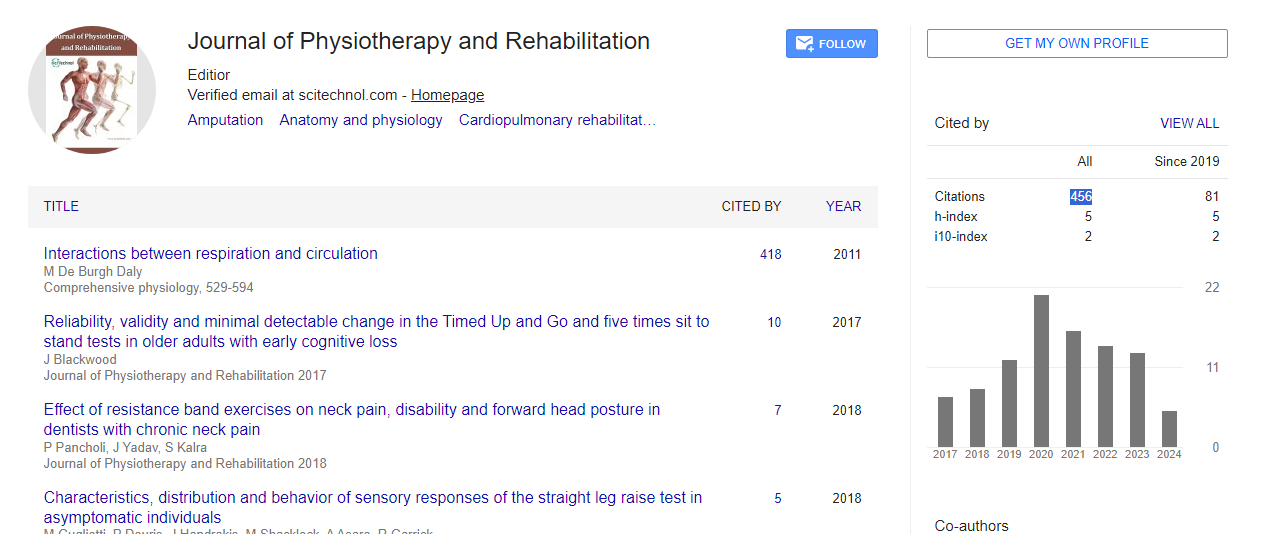Opinion Article, J Physiother Rehabil Vol: 5 Issue: 11
Brain Plasticity and Stroke Rehabilitation
Solveig Danielsen*
Department of Agricultural Bioscience, University of Toronto, Mexico city, Mexico
*Corresponding author: Solveig Danielsen, Department of Agricultural Bioscience, University of Toronto, Mexico city, Mexico, E-mail: Solveig_danielsen@yahoo.com
Received date: 02 November, 2021; Accepted date: 23 November, 2021; Published date: 30 November, 2021
Abstract
Kinesiology is the scientific study of human body movement. Kinesiology addresses Physiological, Anatomical, Biomechanical, and Neuropsychological Principles and Mechanisms of Movement. Applications of kinesiology to human health include biomechanics and orthopedics; strength and conditioning; sport psychology; motor control; skill acquisition and motor learning; methods of rehabilitation, such as physical and occupational therapy; and sport and exercise physiology. Studies of human and animal motion include measures from motion tracking systems, electrophysiology of muscle and brain activity, various methods for monitoring physiological function, and other behavioral and cognitive research techniques
Description
Kinesiology is the scientific study of human body movement. Kinesiology addresses Physiological, Anatomical, Biomechanical, and Neuropsychological Principles and Mechanisms of Movement. Applications of kinesiology to human health include biomechanics and orthopedics; strength and conditioning; sport psychology; motor control; skill acquisition and motor learning; methods of rehabilitation, such as physical and occupational therapy; and sport and exercise physiology. Studies of human and animal motion include measures from motion tracking systems, electrophysiology of muscle and brain activity, various methods for monitoring physiological function, and other behavioral and cognitive research techniques.
Kinesiologist Principle
Whereas the term "kinesiologist" is neither a licensed nor professional designation in the United States nor most countries (with the exception of Canada), individuals with training in this area can teach physical education, work as personal trainers and sport coaches, provide consulting services, conduct research and develop policies related to rehabilitation, human motor performance, ergonomics, and occupational health and safety. In North America, kinesiologists may study to earn a Bachelor of Science, Master of Science, or Doctorate of Philosophy degree in Kinesiology or a Bachelor of Kinesiology degree, while in Australia or New Zealand, they are often conferred an Applied Science (Human Movement) degree (or higher). Many doctoral level faculties in North American kinesiology programs received their doctoral training in related disciplines, such as neuroscience, mechanical engineering, psychology, and physiology. Neuroplasticity is also a key scientific principle used in kinesiology to describe how movement and changes in the brain are related. The human brain adapts and acquires new motor skills based on this principle. Maladaptive plasticity is defined as neuroplasticity with negative effects or detrimental consequences in behavior. The brain can be exposed to new stimuli and experiences and therefore learn from them and create new neural pathways hence leading to brain adaptation. These new adaptations and skills include both adaptive and maladaptive brain changes. Motor redundancy is a widely used concept in kinesiology and motor control which states that, for any task the human body can perform, there are effectively an unlimited number of ways the nervous system could achieve that task. The new medical therapy created in Sweden was originally called Roeselare, and later in 1854 translated to the new and invented international word "Kinesiology". The Kinesiology consisted of nearly 2,000 physical movements and 50 different types of massage therapy techniques. They were all used to affect various dysfunctions and even illnesses, not only in the movement apparatus, but also into the internal physiology of man. Thus, the original classical and Traditional Kinesiology was not only a system of rehabilitation for the body, or biomechanics like in modern Academic Kinesiology, but also a new therapy for relieving and curing diseases, by affecting the autonomic nervous system, organs and glands in the body. Kinesiologists work in a variety of roles as health professionals. They work as rehabilitation providers in hospitals, clinics and private settings working with populations needing care for musculoskeletal, cardiac and neurological conditions. They provide rehabilitation to persons injured at work and in vehicular accidents. Kinesiologists also work as functional assessment specialists, exercise therapists, ergonomists, return to work specialists, case managers and medical legal evaluators. They can be found in hospital, long-term care, clinic, work, and community settings. Additionally, kinesiology is applied in areas of health and fitness for all levels of athletes, but more often found with training of elite athletes.
 Spanish
Spanish  Chinese
Chinese  Russian
Russian  German
German  French
French  Japanese
Japanese  Portuguese
Portuguese  Hindi
Hindi 